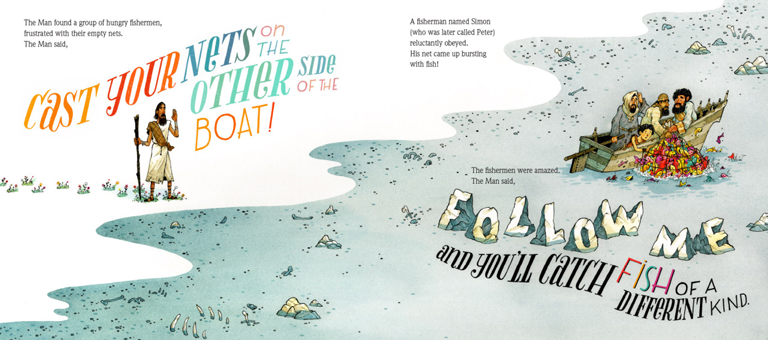
John Hendrix is an illustrator from St. Louis; he’s done some great work over the years and you can check out his portfolio here. Most recently, he has written and illustrated an amazing picture book, Miracle Man: The Story of Jesus. I shared about it in our email newsletter a few weeks ago, and I’m grateful to John for taking some time to have a Q&A with Illustrated Ministry.
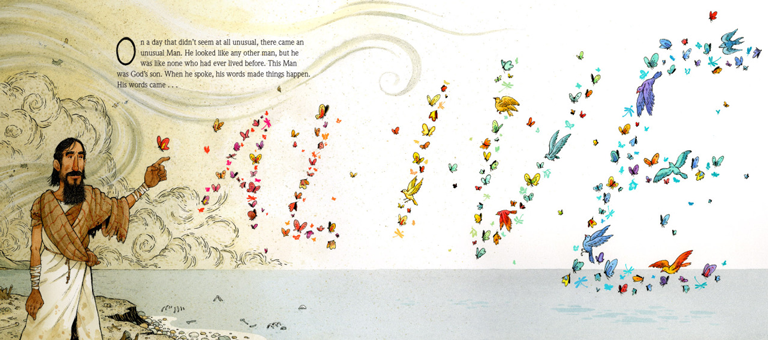
 Illustrated Ministry is trying to provide children with creative ways to engage Bible stories through illustrations and the chance to create art. When was one of the first times you experienced the interaction between your faith and art?
Illustrated Ministry is trying to provide children with creative ways to engage Bible stories through illustrations and the chance to create art. When was one of the first times you experienced the interaction between your faith and art?
This is a good question. I think that the very first time I experienced art and faith together was in the wonderful stained glass windows in the church I grew up in. My home church, Kirkwood United Methodist in St. Louis, was a very interesting piece of architecture that was not a traditional ‘cathedral’ style church. Looking like an upside-down ark, it was very Avant grade, built in the modernist period of the 1950s. So, the designers commissioned these really strange, graphic/modernist stained glass windows that I just love to this day. Sadly, I never had a kid’s Bible that was of much value to me; I wish I had one! The only images I really saw of Jesus were the classic “bearded lady” paintings of him. In many ways, that is why I made Miracle Man. To give children some wonderful images to think about when learning about Jesus.
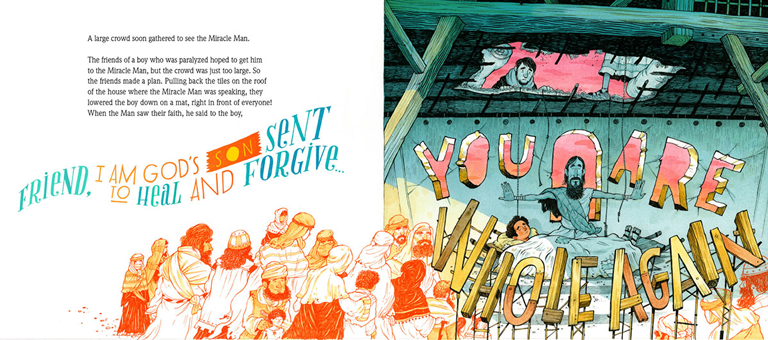
What are some ways that you think the church today should be engaging children with art, as a way of exploring their faith?
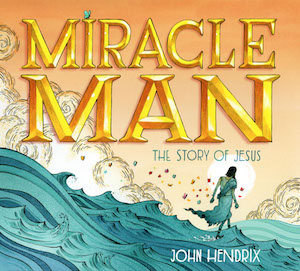 Well, unfortunately, when the reformation happened, the Protestants threw out the imagery of the Catholic Church (with many good reasons for doing so…) but, they never re-corrected the error and an entire wing of faith was turned into an entirely mental experience. To this day, I think many evangelicals are very uncomfortable with faith/bible imagery that is not intensely literal. Some of it may be a fear of doing something blasphemous, or not representing the Bible accurately.
Well, unfortunately, when the reformation happened, the Protestants threw out the imagery of the Catholic Church (with many good reasons for doing so…) but, they never re-corrected the error and an entire wing of faith was turned into an entirely mental experience. To this day, I think many evangelicals are very uncomfortable with faith/bible imagery that is not intensely literal. Some of it may be a fear of doing something blasphemous, or not representing the Bible accurately.
Of course, this is a good thing to want to represent ideas and stories “faithfully”… but what does that idea really mean? We need more visual metaphors, just like the Renaissance painters used. I often think about this quote: “Painting is the literature of the laity” … now, this was from a time when the people in the pews couldn’t read the Bible. They didn’t have Bibles in their house, and they couldn’t read them! They needed the images to tell the story. I’d like to think our adults in the pews need just as many images as the children!
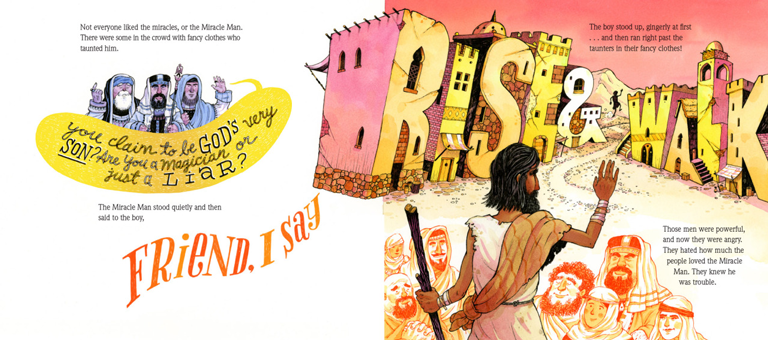
You’ve clearly done a lot of work as an illustrator and author; what inspired you to begin to work on Miracle Man: The Story of Jesus?
It is a story I’ve always wanted to tell, I just figured I’d wait until I was 70 years old and had figured out all of my work and could really apply some life lessons to it. Ha. Well, my dream project came a bit earlier than I imagined. It is the perfect pitfall of the ‘dream project.’ There is so much enjoyment in doing this story, but so much you can get wrong! Beyond what you want to put in, even harder, is what you choose to leave out! As I did the research before I started, I was looking at books that exist about Jesus. I was astonished about how little license people took with the visual metaphor of his life. The best book I found, visually, about Jesus was this thin little book by Moebius of all people (the famous comic artist) called Apres Jesus Christ. But, I don’t think he was a believer, so I wanted to make a book, as a follower of Christ, that was full of evocative imagery.
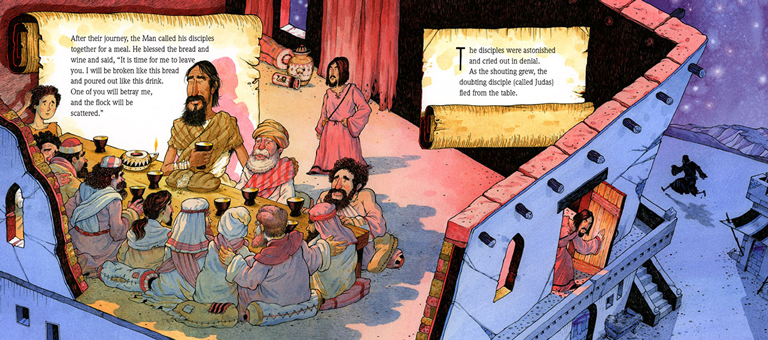
One of the most striking aspects of this book, for me at least, is your use of drawn type and hand lettering. How do you go about deciding how you’re going to convey parts of the story through your drawn type?
Well, the basic visual concept of the book is that when Jesus comes on the scene, he injects life and color in the drab landscape. Part of that metaphor is that his words come to life as well… so I really tried to make his words important. Both in what text I selected, to how I chose to pull that text out of the image itself. So, the text becomes very important to the story (and kids love ‘finding’ the letters scattered throughout the pages). It is a kind of embodiment of “word made flesh” but, instead, “words made environment.” I think it sort of visually represents how those people who experience Christ on earth were surrounded by his words, his ideas. The incarnation of Jesus changed their landscape into his own.
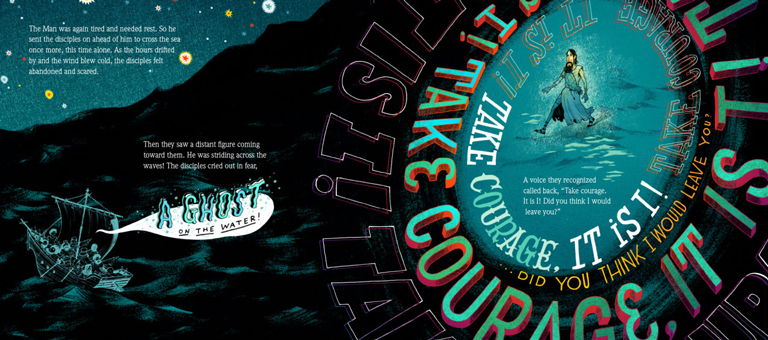
What’s next for you? What projects are you working on now that you can share with us?
My next project is a kind of long format graphic novel about Dietrich Bonhoeffer, a German pastor, and spy with the resistance against the Nazis. He worked with the plotters who tried to assassinate Hitler and was executed for his role in helping Jews escape Germany. Will be out fall 2017!
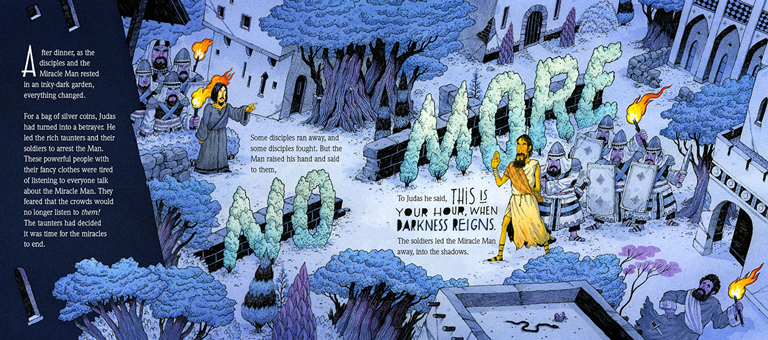
Win a FREE Copy of Miracle Man
I have two signed copies of John’s book, Miracle Man, to give to two lucky members of our Illustrated Ministry community! To enter, simply share the Facebook status below or retweet the tweet below. Make sure you include the hashtag #MiracleManStoryofJesus in both the Facebook post and tweet, because that’s how we’ll search for our winner. We’ll pick two winners at the end of the day on Tuesday, April 19. So start sharing!
Check out this great interview with John Hendrix, author of Miracle Man: The Story of Jesus. It’s a beautifully…
Posted by Illustrated Ministry on Monday, April 18, 2016
Come read a great interview with @hendrixart, author of Miracle Man. #MiracleManStoryofJesus https://t.co/MY91WRbQ4B
— Children’s Ministry (@IllustratedCM) April 19, 2016
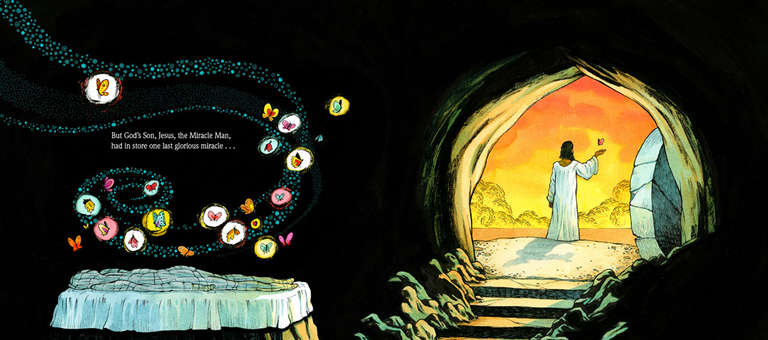

[…] a Q&A with the author here. Buy it […]